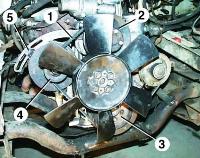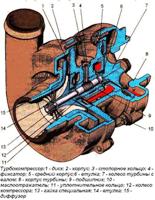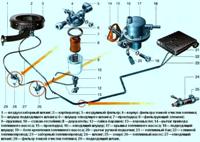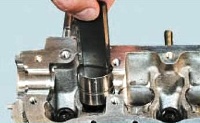We remove the tips of the spark plugs together with the high-voltage wires, the ignition coils (you can only disconnect the connectors by leaving them on the valve cover), the throttle cable and, having disconnected the wires from the sensors of the lubrication and cooling systems, remove the wiring harness from the brackets of the head cover .
Drain the coolant and remove the upper radiator hoses and the mass air flow sensor together with the air ducts.

Using a screwdriver, loosening the clamps, remove the large ventilation hose

Remove the small crankcase ventilation hose.
Using a 12 key, we unscrew the screws securing the block head cover

Remove the block head cover
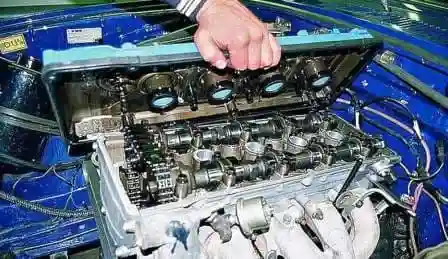
With the head at 36, we set the crankshaft to the TDC position of the compression stroke of the first cylinder by turning it by the pulley mounting bolt (the mark on the crankshaft pulley should coincide with the protrusion on the front cover of the cylinder block, and the marks on the camshaft sprockets should be at the upper edges block heads).

With a 12 key, unscrew the four bolts and remove the front cover of the block head.
We remove the upper hydraulic tensioner (described in the article - Hydraulic chain tensioner for the ZMZ-406 engine) .

Using a 6 hexagon wrench, unscrew the two screws and remove the upper chain guide.
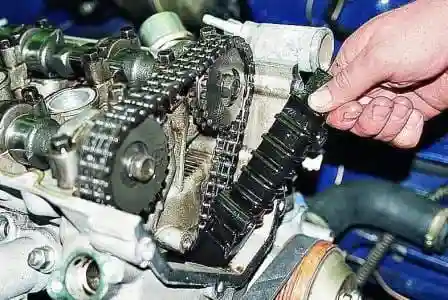
Having unscrewed the two screws with a 6-point wrench, remove the middle chain guide.
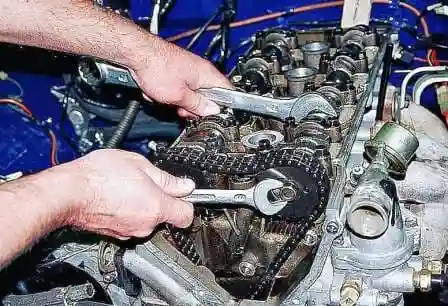
With a key of 17, we unscrew the bolt securing the exhaust camshaft sprocket, holding the shaft with a key of 30.

Remove the asterisk. Similarly, remove the sprocket from the second camshaft.

With a 12 key, we unscrew the four bolts securing the front cover of the camshafts.
Consistently, half a turn, loosen the bolts securing the camshaft covers until the valve springs stop pressing the shafts and unscrew the bolts.

Remove the front cover and remove the plastic half rings

Remove the remaining covers.

Remove the camshafts
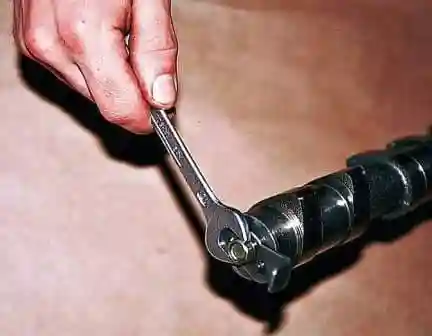
Using a 12 key, we unscrew the bolt securing the phase sensor plate and install it on the new exhaust valve shaft
After removing, wash all parts with gasoline, wipe and dry.
Inspect the camshafts.
If burrs, cavities, cracks are found on the journals and cams, replace the shafts.
Measure the diameter of the camshaft journals.
The nominal diameter of the first neck (closest to the sprocket) is 42.0 + 0.050 -0.075 mm, the maximum allowable diameter is 41.9 mm.
The nominal diameter of the remaining necks is 35 + 0.050 -0.075 mm, the maximum allowable diameter is 34.9 mm.
If the diameter of at least one journal is less than the limit, replace the camshaft.
Measure the height of the cams. The nominal height of the cam is (46.0-0.25) mm, the maximum allowable height is 45.5 mm.
If the height of at least one cam is less than the limit, replace the camshaft.
Remove small scratches on the necks and cams by grinding, and then polish the necks and cams.

Install the camshaft on two prisms and measure the runout on the middle neck with an indicator.
Nominal runout 0.025 mm, maximum allowable runout 0.04 mm.
If the runout is greater, replace the camshaft.
Check the clearances in the camshaft bearings.
To do this, place a cylindrical mandrel with a diameter of 35.0-0.02 mm in the camshaft bearing, lubricated with clean engine oil, to center the cover.
Install the camshaft cover, tighten the cover bolts to 19-23 Nm (1.9-2.3 kgcm).
Remove the drift towards the rear end of the cylinder head.
Measure the inner diameter of the camshaft bearing and calculate the gap as the difference between the diameter of the bearing and the diameter of the corresponding camshaft journal.
The maximum allowable gap is 0.15 mm.
If the clearance in at least one camshaft bearing is greater than the allowable value, replace the shaft or cylinder head.
The camshaft covers are machined complete with the block head, so they cannot be interchanged.
Each lid has a serial number engraved on it.
The numbering of the covers starts from the front support (closest to the gear) of the intake camshaft.
Next, the exhaust camshaft caps are numbered on the camshaft gear side.
A phase sensor plate is installed at the rear end of the exhaust camshaft.
Lubricate the journals and cams of the camshafts and bearings in the cylinder head with clean engine oil.
Lay the camshafts in the cylinder head:
- intake camshaft - up with a pin for installing an asterisk, exhaust camshaft - with a pin to the right.

Lubricate the front cover 1 of the camshafts with the thrust half rings 2 installed in it with clean engine oil.
Install cover 1 on the guide bushings in the camshaft bearings.
In this case, half rings 2 must enter the grooves on the camshafts.
Lubricate covers 3 and 7 with clean engine oil and install them on the guide bushes in the camshaft bearings.
Turn the bolts of the covers until the covers come into contact with the supports.
Lubricate the rest of the camshaft covers with clean engine oil and reinstall them.
Tighten the camshaft cover bolts to 19-23 Nm (1.9-2.3 kgcm).
Check for ease of rotation of the camshafts.
To do this, turn each shaft with a wrench by the square on the shaft so that the valve springs of any cylinder are completely compressed (the cams of the shaft are directed downwards).
Turn the camshaft slightly again, it should turn further under the action of the apan springs until the next cams come into contact with the valve lifters.

Turn the camshafts so that the alignment pins of the sprockets are horizontal and directed in different directions (the position of the camshafts corresponds to the position of the piston of the 1st cylinder at TDC).
Put on the camshaft drive chain (see " How to replace timing chains and gears ZMZ-405, ZMZ-406").
Install the chain tensioner, see "ZMZ-406 engine chain tensioner".
Install all removed parts in the reverse order of removal.







